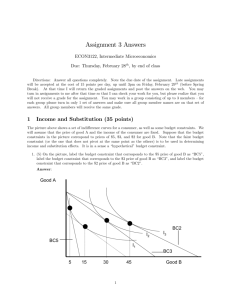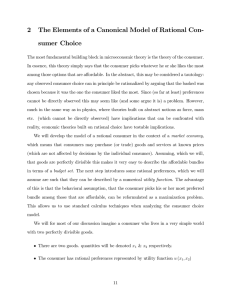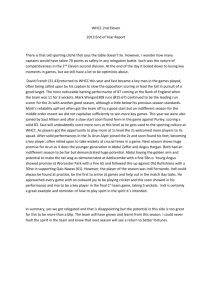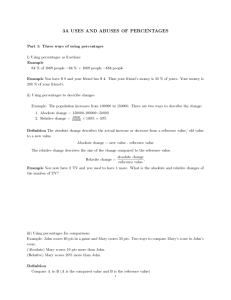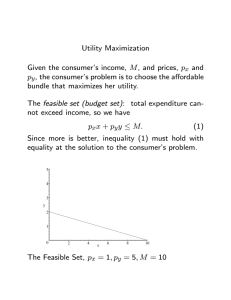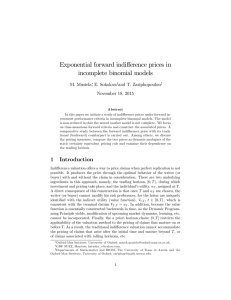1 The Budget Constraint: What the Consumer Can Afford
advertisement
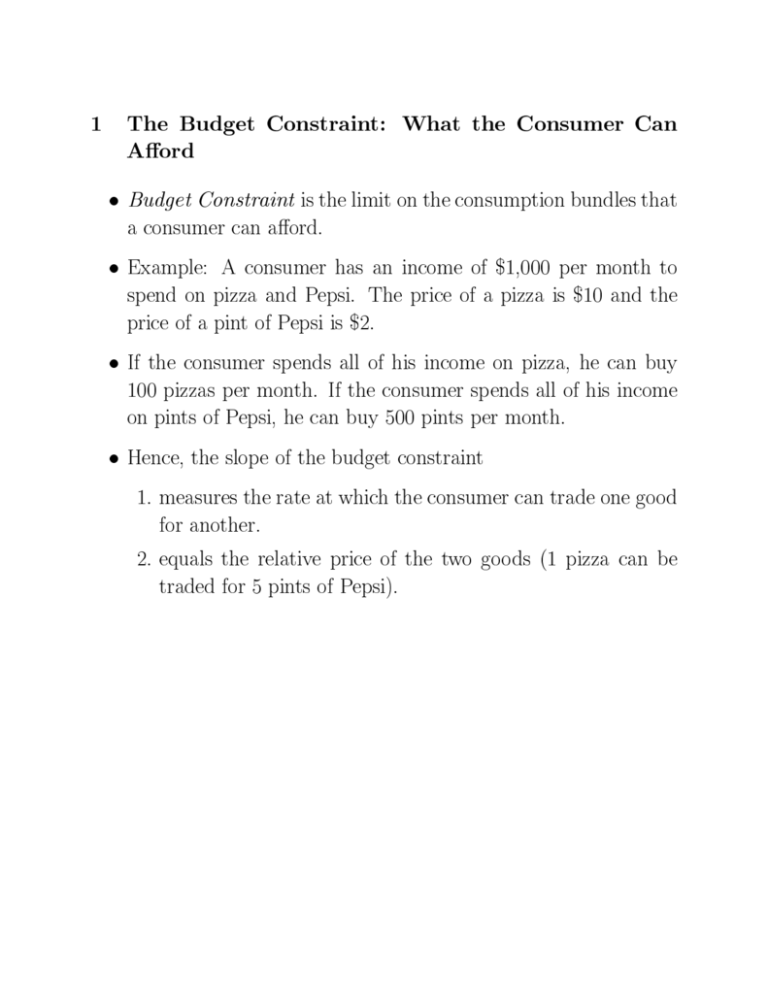
1 The Budget Constraint: What the Consumer Can Aord Budget Constraint is the limit on the consumption bundles that a consumer can aord. Example: A consumer has an income of $1,000 per month to spend on pizza and Pepsi. The price of a pizza is $10 and the price of a pint of Pepsi is $2. If the consumer spends all of his income on pizza, he can buy 100 pizzas per month. If the consumer spends all of his income on pints of Pepsi, he can buy 500 pints per month. Hence, the slope of the budget constraint 1. measures the rate at which the consumer can trade one good for another. 2. equals the relative price of the two goods (1 pizza can be traded for 5 pints of Pepsi). 2 Preferences: What the Consumer Wants A consumer is indierent between two bundles of goods and services if the two bundles suit his tastes equally well. Indierence Curve is a curve that shows consumption bundles that give the consumer the same level of satisfaction. Marginal Rate of Substitution is the rate at which a consumer is willing to trade one good for another. The marginal rate of substitution is equal to the slope of the indierence curve. 1. Because indierence curves are not straight lines (in general), the marginal rate of substitution is not the same at all points on a given indierence curve. 2. The rate at which a consumer is willing to trade one good for the other depends on how much of each good he is already consuming. 2.1 Four Properties of Indierence Curves 1. Higher indierence curves are preferred to lower ones. 2. Indierence curves are downward-sloping. (a) In most cases, the consumer would like more of both goods. (b) Thus, if the quantity of one good increases, the quantity of the other good must fall in order for the consumer to remain equally satised. 3. Indierence curves do not cross. 4. Indierence curves are convex. Question: Why? Answer: People prefer averages over extremes. 2.2 Two Extreme Examples of Indierence Curves 1. Perfect Substitutes have straight-line indierence curves. Example: Nickels and dimes. 2. Perfect Complements have right-angle indierence curves. Example: Right shoes and left shoes. 3 Optimization: What the Consumer Chooses The consumer would like to end up on the highest possible indierence curve, but he must also stay within his budget. The highest indierence curve the consumer can reach is the one that is tangent to the budget constraint. The point where they touch is called the optimum. At this point, the marginal rate of substitution is equal to the relative price of the two goods. A change in income shifts the budget constraint. Recall that 1. Normal Good is a good for which an increase in income raises the quantity demanded. 2. Inferior Good is a good for which an increase in income reduces the quantity demanded. If the price of only one good changes, the budget constraint will tilt. The change in consumption can be decomposed into two eects: 1. Income Eect is the change in consumption that results when a price change moves the consumer to a higher or lower indierence curve. 2. Substitution Eect is the change in consumption that results when a price change moves the consumer along a given indierence curve to a point with a new marginal rate of substitution. Suppose that the price of Pepsi falls. 1. The decrease in the price of Pepsi will make the consumer better o. Thus, if pizza and Pepsi are both normal goods, the consumer will want to spread this improvement in his purchasing power over both goods. This is the income eect and will make the consumer want to buy more of both goods. 2. At the same time, the consumption of Pepsi has become less expensive relative to the consumption of pizza. This is the substitution eect and it will tend to make the consumer want to purchase more Pepsi and less pizza. 4 Application 4.1 How Do Wages Aect Labor Supply? Example: Sally has 100 hours per week that she can devote to working or enjoying leisure. Her hourly wage is $50, which she spends on consumption goods. Hence, she can choose any combination between $5,000 consumption and 100 hours of leisure. If Sally's wage increases, her budget constraint will shift outward. 1. The budget constraint will become steeper, because Sally can get more consumption for every hour of leisure that she gives up. 2. Consumption will rise, because both of the income and substitution eects move in that direction. 3. When the wage rises, leisure becomes relatively more expensive. Therefore, Sally will want to consume less leisure. However, when Sally's wage rises, her income rises causing her to increase her to want more leisure (since it is a normal good). The end result depends on which eect is dominant. 4.2 How Do Interest Rates Aect Household Saving? Example: There are two time periods. Currently, Sam is young and working and able to earn a total income of $100,000. In the next period, Sam is old and (re)tired. He will have to consume using funds he saved while young. Assume that the interest rate is 10 percent. The interest rate determines the relative price of these two goods. For every dollar that Sam saves while he is young, he can consume $1.10 when he is old. If Sam saves nothing, he will consume $100,000 when he is young and zero when he is old. Likewise, if he consumes nothing when he is young, he will be able to consume $110,000 when he is old. If the interest rate rises to 20 percent, two possible outcomes could occur. 1. The substitution eect suggests that Sam would lower the amount of consumption when young and save more for the future. 2. The income eect suggests that Sam increase his consumption of normal goods. Since \consumption when young" is a normal good, Sam will want to save less.
